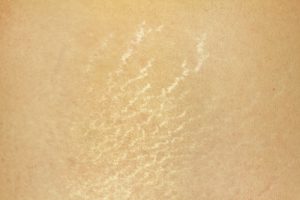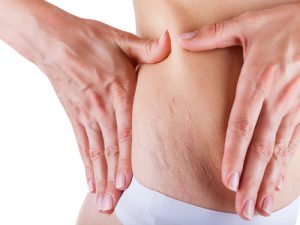 Men and women can get stretch marks on several parts of their bodies, including the belly, thighs, hips,breasts, upper arms, and lower back. The marks form in the dermis, the middle layer of skin that allows it to retain its shape. When constantly stretched, the dermis can break down, leaving stretch marks behind. This kind of scarring happens when skin doesn’t bounce back after it’s been stretched by pregnancy, weight gain, or extreme weight loss. The marks often start off looking reddish or purplish and then become glossy, making the skin appear to be streaked in silver or white.
Men and women can get stretch marks on several parts of their bodies, including the belly, thighs, hips,breasts, upper arms, and lower back. The marks form in the dermis, the middle layer of skin that allows it to retain its shape. When constantly stretched, the dermis can break down, leaving stretch marks behind. This kind of scarring happens when skin doesn’t bounce back after it’s been stretched by pregnancy, weight gain, or extreme weight loss. The marks often start off looking reddish or purplish and then become glossy, making the skin appear to be streaked in silver or white.
Treatment
 There are several treatments for stretch marks, but none of them are 100% effective. The degree of success will depend on your skin tone, age, amount of sun damage your skin has had, and even your diet.
There are several treatments for stretch marks, but none of them are 100% effective. The degree of success will depend on your skin tone, age, amount of sun damage your skin has had, and even your diet.
Treatments include:
• Surgical methods. Dermabrasion, chemical peels, or laser surgery
• Lotions and creams. Prescription Retin-A or Tazorac gels or creams stimulate collagen to help improve stretch marks over time.
Only the pink/purple-colored ones will fade though; the grey/white marks are mature and do not respond to treatment. Over-the-counter products like Lac-Hydrin lotion hydrate the skin to help to reduce the appearance of stretch marks. If you are pregnant and worried about getting stretch marks, talk to your doctor at the beginning of your pregnancy, before they form. Steady weight gain of 25 to 30 pounds over the 9 months of pregnancy may help reduce them.
Health insurance isn’t likely to cover stretch mark treatment because it is considered a cosmetic problem, even if they are very noticeable. Talk to your health insurance company if you have questions about your coverage.





